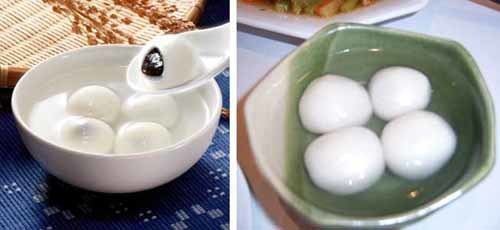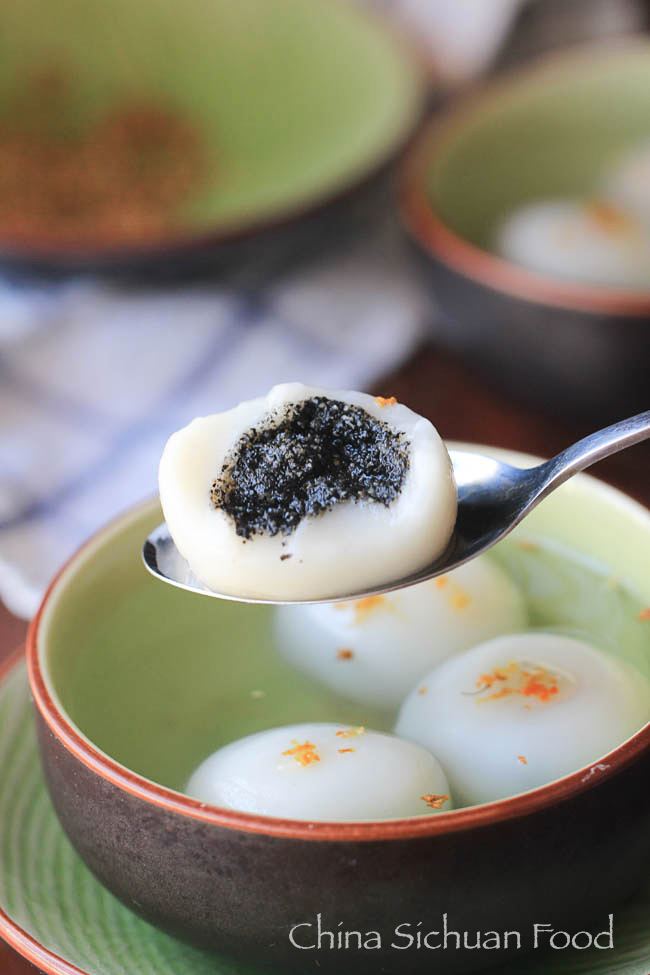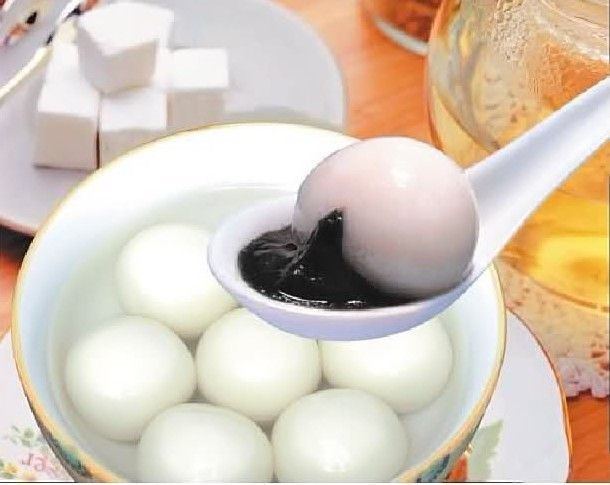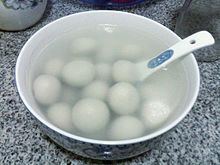Alternative names yuanxiao Place of origin China | Main ingredients Glutinous rice flour | |
 | ||
Variations Regional variants differing in ingredients and method Similar Glutinous rice, Jiaozi, Zongzi, Jiuniang, Tong sui | ||
Tangyuan or tang yuan (simplified Chinese: 汤圆; traditional Chinese: 湯圓; pinyin: tāngyuán) is a Chinese food made from glutinous rice flour mixed with a small amount of water to form balls and is then cooked and served in boiling water. Tangyuan can be either small or large, and filled or unfilled. They are traditionally eaten during Yuanxiao or the Lantern Festival, but also served as a dessert on Chinese wedding day, Winter Solstice Festival (Chinese: 冬至; pinyin: Dōngzhì), and any occasions such as family reunion, because of a homophone for union (simplified Chinese: 团圆; traditional Chinese: 團圓; pinyin: tuányuán)
Contents
- Name
- Geographical differences
- Cultural significance
- Ingredients
- Serving
- Availability
- Related dishes
- References

Name

Historically, a number of different names were used to refer to tangyuan. During the Yongle era of the Ming Dynasty, the name was officially settled as yuanxiao (derived from the Yuanxiao Festival), which is used in northern China. This name literally means "first evening", being the first full moon after Chinese New Year, which is always a new moon.

In southern China, however, they are called tangyuan or tangtuan. Legend has it that during Yuan Shikai's rule from 1912 to 1916, he disliked the name yuanxiao (元宵) because it sounded identical to "remove Yuan" (袁消), and so he gave orders to change the name to tangyuan. This new moniker literally means "round balls in soup". Tangtuan similarly means "round dumplings in soup". In the Hakka and Cantonese varieties of Chinese, "tangyuan" is pronounced as tong rhen and tong jyun respectively. The term "tangtuan" (Hakka: tong ton, Cantonese: tong tyun) is not as commonly used in these varieties as tangyuan.
Geographical differences

This type of glutinous rice flour dumpling is eaten in both northern and southern China. Southerners refer them as "tangyuan" and northerner refer them as "yuanxiao". The fillings consist of sweet fillings such as sugar, sesame, osmanthus flowers, sweet bean paste and sweetened tangerine peel are used.
Cultural significance

For many Chinese families in mainland China as well as overseas, tangyuan is usually eaten together with family. The round shape of the balls and the bowls where they are served, come to symbolise the family togetherness.
Ingredients

While tangyuan was originally a food eaten during festivals, it has become a dessert consumed year-round rather than simply a festival food. For instance, tangyuan is traditionally in white color. Yet, in order to cater to consumers’ needs and changing tastes, dessert specialty shops create new flavors or colors of tangyuan by substituting the traditional filling with chocolate, mashed potato and pumpkin paste. Thus, tangyuan has already evolved into a dessert that is consumed by Chinese from time to time throughout the year and is no longer limited to festivals. In both filled and unfilled tangyuan, the main ingredient is glutinous rice flour. For filled tangyuan, the filling can be either sweet or savoury. Northern variations mix sesame, peanuts, sweet bean paste and place them into bamboo baskets with rice flour, sprinkle water continuously on the rice flour to form the fillings and form round balls. Southern variations are typically larger, and are made by wrapping the filling into sticky rice flour wrapping and scrunching them into balls.
Sweet fillings can be:
Serving
Tangyuan are first cooked in boiling water. Once cooked, savoury filled tangyuan are served in a clear soup broth, whilst sweet filled tangyuan are served in a ginger infused syrup.
Unfilled tangyuan are served as part of a sweet dessert soup (known in Cantonese cuisine as tang shui, which literally means "sugar water"). Common types include:
Availability
The most notable varieties come from Ningbo and Wenzhou in Zhejiang Province. However, they are traditionally eaten throughout China.
Tangyuan have also come to be associated with the Winter Solstice and Chinese New Year in various regions. Today, the food is eaten all year round. Mass-produced tangyuan are commonly found in the frozen food section of Asian supermarkets in China and overseas.
Related dishes
In southern Vietnam, a similar dish, called chè xôi nước, is served in a mild, sweet liquid flavoured with grated ginger root. In northern Vietnam, bánh trôi (also called bánh trôi nước) and bánh chay are also very similar, with the latter being served with coconut milk.
In the Philippines, ginataang bilo-bilò is also served in coconut milk, and sometimes local produce such as plantains (sabà), tapioca, and/or sweet potatoes are cook in.
In Indonesia, an adapted version, called Wedang Ronde (Wedang in Javanese means Beverages, and Ronde means round ball), is one of the most popular comfort food during chill temperature that's been served in mild crushed and thin sliced ginger root soup with palm sugar, frequently added fragrant pandan leaves, crushed grounded peanuts, and the glutinous rice ball itself that usually red, green, or white coloured and filled with crushed grounded peanuts and sugar. In a way, Wedang Ronde is Javanese traditional beverage Wedang Jahe served with glutinous rice balls.
